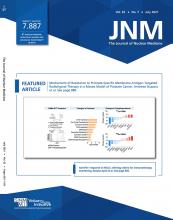TO THE EDITOR: I have read with interest the commentary by Pillarsetty et al. (1) in the December issue. Although the idea of investigating nuclear medicine–based solutions for treatment of coronavirus disease 2019 (COVID-19) is interesting and is potentially deserving of comment, the commentary by Pillarsetty et al. raises some concerns.
First, the only experimental data reported in the commentary are binding of the commercial antibody developed toward the spike protein of severe acute respiratory syndrome coronavirus 2 (SARS-CoV-2) to that same commercial spike protein attached to magnetic beads. This piece of data, which is a simple quality control procedure for any antibody reagent received by a laboratory, does not prove the utility of detecting a virus such as SARS-CoV-2 in vivo.
Second, the authors did not use in their experiments a dead virus, a live virus, an attenuated strain, or a relevant in vivo model of COVID-19 infection, such as a ferret model (2). However, the title of their commentary promises not just one but several treatment options for COVID-19. The current situation, in which hundreds of thousands of COVID-19 patients are dying across the world, warrants proof of a therapeutic claim in at least one in vivo model of the disease.
Third, there is another issue with the title of the commentary. It states that the approach of targeting viral infections with radiolabeled antibodies for imaging or therapy is “oncology-inspired,” when in fact at least 18 papers on targeting of viral infections for therapy with radiolabeled antibodies have been published since 2006 (3–7) and all of them have been listed on PubMed, presented at multiple nuclear medicine meetings and Department of Energy meetings, and covered by the press and Newsline. There have also been publications on radiolabeled-antibody imaging of viral infections in vivo in non-human primates (8,9).
Finally, the commentary does not discuss the enormous radioresistance of virions and the implications of such radioresistance for suggested therapy targeting the virus directly. For example, 18 kGy of radiation are required to sterilize bone grafts from HIV virions (10), which belong to the same RNA virus type as SARS-CoV-2.
DISCLOSURE
Ekaterina Dadachova is a consultant and received research support from Actinium Pharmaceuticals and RadImmune Therapeutics. No other potential conflict of interest relevant to this letter was reported.
Footnotes
Published online May 7, 2021.
- © 2021 by the Society of Nuclear Medicine and Molecular Imaging.







